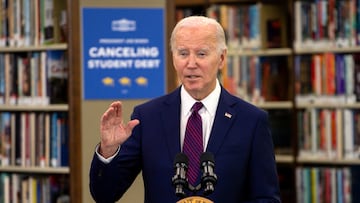When will Biden’s SAVE student loan debt relief plan be implemented?
The implementation of President Biden’s SAVE program to provide dome relief to student debt holders is on pause after facing opposition from the courts.

After the Supreme Court struck down President Joe Biden’s plan to forgive student debt, a new program was announced to provide tangible benefits for millions, though still falling far short of his campaign promise.
Together with Education Secretary Miguel Cardona, the two explained that the new path forward to providing relief would involve revamping the Income-Driven Repayment (IDR) plan, which only a small percentage of the millions eligible were able to take advantage of. The Saving on a Valuable Education (SAVE) plan was announced in January 2023, which will replace the Revised Pay As You Earn (REPAYE) plan, which is touted as being “the most affordable repayment plan in history.”
Implementation has been paused by the courts
The program was set to go into effect in July but has been held up in the courts. On July 18, a court stayed a motion to prevent the implementation. The department released a statement providing an update on the case shortly after informing those who had enrolled that they were entering a period of forbearance. “Borrowers enrolled in the SAVE plan are being moved into forbearance. During forbearance, SAVE borrowers will not have to make payments,” reported the Department. Borrowers should be aware, however, that “time in forbearance will not count toward Public Service Loan Forgiveness or Income-Driven Repayment (IDR) loan forgiveness.”
In late July, the Department announced that it would send personalized messages to borrowers detailing the student debt relief programs that they may be able to enroll in.
How much will the plan reduce payments by?
The SAVE plan will reduce monthly payments for borrowers who meet certain income requirements to zero. The proposed regulations would increase the amount of income protected from repayment from 150 percent of the Federal poverty guidelines to 225 percent. That level is roughly the equivalent of a $15 hourly wage based on the 2022 guidelines for a single borrower working full-time. So, a single borrower earning less than $32,800 would have their monthly payments reduced to zero dollars. The same would be true for a borrower in a household of four with an annual income below $67,500. Under the most generous current income-driven repayment (IDR) plans, the amounts are around $20,400 and just above $41,600, respectively.
This is because, under the SAVE plan, the amount borrowers would be required to pay above the increased level of 225 percent will be half of the most generous IDR plan. Payments on loans borrowed for undergraduate studies will be reduced to just five percent of discretionary income. Those who have both undergraduate and graduate loans will pay a weighted average of between 5 percent and 10 percent of their income based on the original principal balances.
At the same time, it will prevent unpaid interest from accumulating as long as repayments are made on time. The new program will also shorten the time borrowers need to make monthly payments to as little as 10 years before an outstanding debt is canceled. According to the Department of Education, this could be the case for 85 percent of community college borrowers after entering repayment. The thresholds will be higher in Hawaii and Alaska, and those whose income exceeds them could see savings of at least $1,000 per year compared to other IDR plans.
Until the courts rule on the legality of the program, it will not be able to be implemented.





